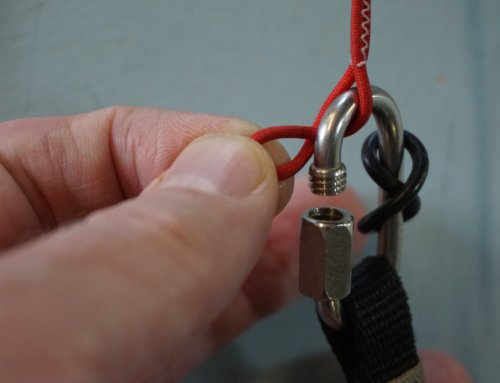Since we started using laser equipment to measure glider linesets at Aerofix, we’ve measured over a thousand gliders. Measuring the distance from the risers to every attachment point on a canopy reveals exactly where line lengths deviate from specification, and the program we wrote enables us to determine exactly what trim adjustments are needed. Our experience confirms that all wings go out of trim over time, and the patterns we see are often predictable. So what are the typical patterns, and why do lines shrink anyway?
The most common pattern of all is for the more lightly-loaded rear lines to shrink more than the front lines. That increases the angle of attack, slowing down the trim speed, bringing the wing closer to the stall point and making a spin more likely. It also reduces the top speed of the glider when accelerated. For Dyneema lines, this shrinkage pattern emerges after 25 hours flying, as the lineset settles in. For lines made of aramid (for which Kevlar is a well know brand name), it can be several years before the shrinkage is sufficient to require any trim adjustment.
But why does this shrinkage occur? We have put this question to the two leading European line manufacturers, Edelrid (who make the widely used A8000U unsheathed aramid) and Liros (their forte is PPSL Dyneema-type sheathed line), but they have yet to respond. I’m chasing them for a reply, and will report back when I hear from them. However, several glider manufacturers did offer their views about shrinkage, which I wanted to share.
Thinking first about sheathed lines, Patrick Holmes, the UK importer for Gin, Skywalk and BGD, comments that “All sheathed lines shrink, mostly because of the sheath trying to expand and contract under various conditions.” Silas Bosco of the R&D team at Advance highlights “the very flat braiding angle of the cover, which tends to get bigger in diameter and therefore shortens the line”. It’s worth saying that the sheathing is finely woven from a different material to the core, usually polyester, whereas the load bearing part of the line itself is only very loosely braided. So the interaction between the sheath and the core seems to be a factor, as the line is subjected to fluctuating loading in flight, and differing environmental conditions.
But unsheathed lines also shrink, and clearly that must have a different cause. Patrick believes this is down to “the material weave [which] tries to expand and contract, therefore shortening the line.” He points out that Dyneema has a very low coefficient of friction, comparable to Teflon, whereas Kevlar has a relatively high coefficient of friction: that means that the fibres of Dyneema can slide over each other much more easily as shrinking takes place, and Kevlar is more resistant to this process.
All the manufacturers we speak to agree that environmental factors can exacerbate shrinking: heat (both high temperatures or exposure to a wide fluctuation) and damp are the principal conditions to be avoided. So avoid leaving your wing in a hot car, particularly if it’s recently been in the freezing temperatures of an aircraft hold. Take your wing out to air if it got damp before packing away on the hill, and never store it anywhere damp.
Do lines stretch? Our experience is that it is quite rare. Russ Ogden of Ozone comments that “modern 2–liners with fully optimised line sets do exhibit stretching of the A lines to begin with but then settle”. It’s important to note that when we talk about shrink and stretch compared to the manufacturer’s specification, we’re talking about the length of the line under the standard measuring tension of 5kg. Of course, all lines are elastic and elongate under load, but that’s not what we’re discussing here.
Retrimming a glider involves taking extra loops at the maillon, or in the upper cascades, to reduce the effective length of less shrunken lines to match the lines that have shrunk the most. It used to be thought that it was a good idea to stretch shrunken lines under, for example, a 20kg load. If a fellow pilot – or service workshop even – suggests this, our advice, and that of manufacturers, is don’t do it, as the effect will only be temporary. As Russ says, “I totally agree about the futility of stretching, it’s a very short term solution.”
When determining any trim adjustments, we compare the overall line lengths we measure to data from the manufacturer, which is usually readily available for all gliders but those made by defunct manufacturers. Overall line lengths are not simply a matter of adding up all the lengths of individual lines, as there are other factors to take into account. The main one is that the loops between different lines reduce the effective length: depending on the number of sections (main, mid and upper for example) and the type of line involved, the overall length can be 2 – 3 cm shorter than the sum of the individual line lengths.
We want to caution all pilots and workshops against using any data source for line measuring other than the manufacturer, including DHV’s website. Our experience is that the DHV data is unreliable, and in one case we know of, was significantly at variance with the manufacturer’s data. We raised this with BHPA, who recently obtained a response from DHV which I understand BHPA technical officers are considering. In the meantime, I think it’s important to let pilots know that in their response, the DHV noted that their measurements are done on the glider tested for certification purposes and should not be considered as the blueprint for the line lengths for maintenance purposes. DHV acknowledges that in this context, line measurement data should always be taken from the manufacturer.
Enjoy your flying!
If you want to chat anything through, we’re always happy to offer help and advice over the phone (01433 627195) or by email (info@aerofix.com).


